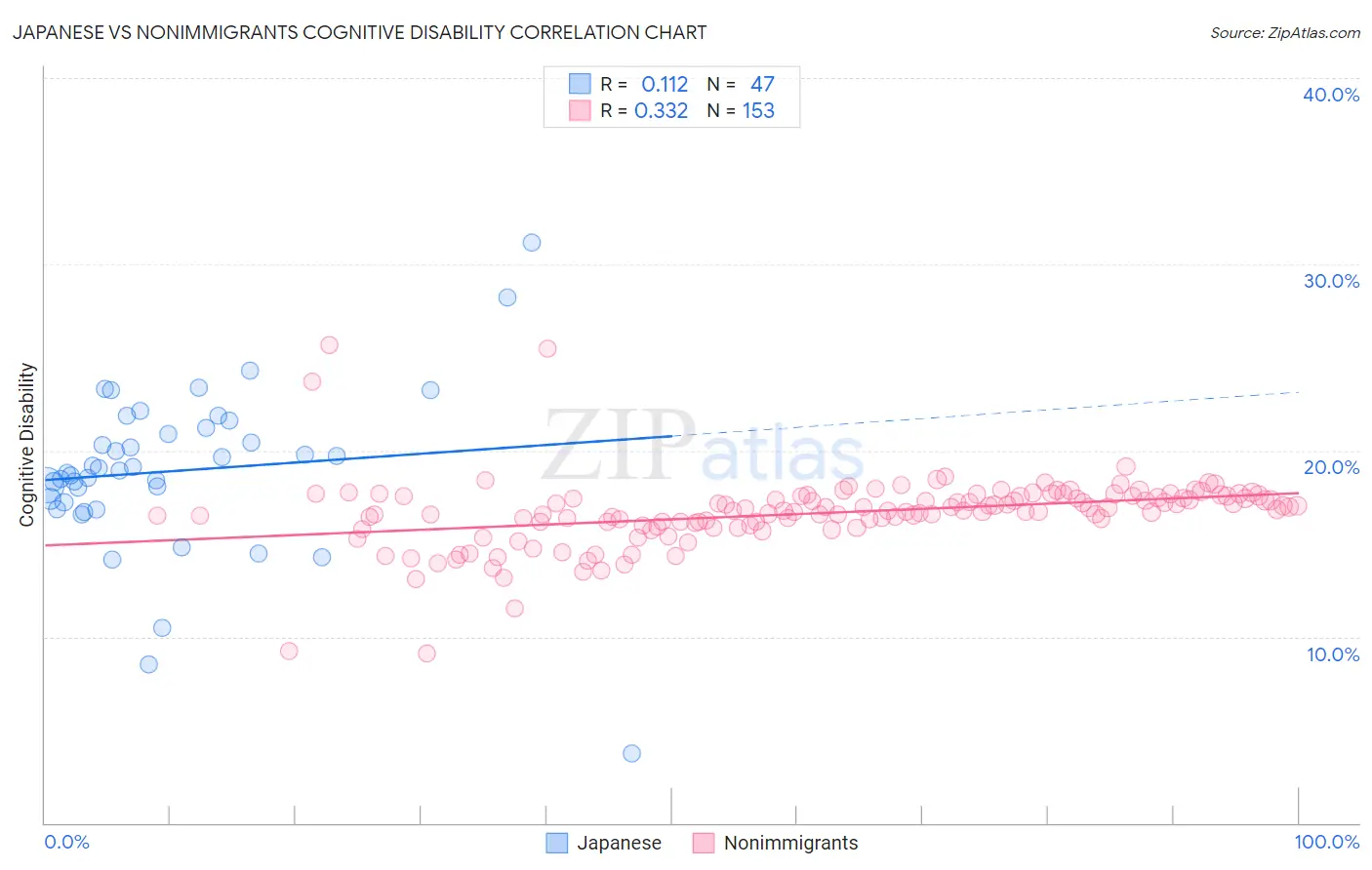Japanese vs Nonimmigrants Cognitive Disability
COMPARE
Japanese
Nonimmigrants
Cognitive Disability
Cognitive Disability Comparison
Japanese
Nonimmigrants
18.3%
COGNITIVE DISABILITY
0.0/ 100
METRIC RATING
298th/ 347
METRIC RANK
17.4%
COGNITIVE DISABILITY
27.4/ 100
METRIC RATING
191st/ 347
METRIC RANK
Japanese vs Nonimmigrants Cognitive Disability Correlation Chart
The statistical analysis conducted on geographies consisting of 249,155,070 people shows a poor positive correlation between the proportion of Japanese and percentage of population with cognitive disability in the United States with a correlation coefficient (R) of 0.112 and weighted average of 18.3%. Similarly, the statistical analysis conducted on geographies consisting of 584,976,337 people shows a mild positive correlation between the proportion of Nonimmigrants and percentage of population with cognitive disability in the United States with a correlation coefficient (R) of 0.332 and weighted average of 17.4%, a difference of 5.0%.

Cognitive Disability Correlation Summary
| Measurement | Japanese | Nonimmigrants |
| Minimum | 3.7% | 9.1% |
| Maximum | 31.2% | 25.7% |
| Range | 27.4% | 16.6% |
| Mean | 18.9% | 16.6% |
| Median | 18.9% | 16.8% |
| Interquartile 25% (IQ1) | 17.2% | 16.0% |
| Interquartile 75% (IQ3) | 21.2% | 17.6% |
| Interquartile Range (IQR) | 4.0% | 1.5% |
| Standard Deviation (Sample) | 4.5% | 1.9% |
| Standard Deviation (Population) | 4.4% | 1.9% |
Similar Demographics by Cognitive Disability
Demographics Similar to Japanese by Cognitive Disability
In terms of cognitive disability, the demographic groups most similar to Japanese are Blackfeet (18.3%, a difference of 0.0%), Ghanaian (18.3%, a difference of 0.030%), Creek (18.3%, a difference of 0.060%), Immigrants from Burma/Myanmar (18.2%, a difference of 0.14%), and German Russian (18.2%, a difference of 0.17%).
| Demographics | Rating | Rank | Cognitive Disability |
| Ottawa | 0.1 /100 | #291 | Tragic 18.2% |
| Iroquois | 0.1 /100 | #292 | Tragic 18.2% |
| Central American Indians | 0.1 /100 | #293 | Tragic 18.2% |
| British West Indians | 0.1 /100 | #294 | Tragic 18.2% |
| German Russians | 0.0 /100 | #295 | Tragic 18.2% |
| Immigrants | Burma/Myanmar | 0.0 /100 | #296 | Tragic 18.2% |
| Blackfeet | 0.0 /100 | #297 | Tragic 18.3% |
| Japanese | 0.0 /100 | #298 | Tragic 18.3% |
| Ghanaians | 0.0 /100 | #299 | Tragic 18.3% |
| Creek | 0.0 /100 | #300 | Tragic 18.3% |
| Immigrants | Ghana | 0.0 /100 | #301 | Tragic 18.3% |
| Barbadians | 0.0 /100 | #302 | Tragic 18.3% |
| Immigrants | Kenya | 0.0 /100 | #303 | Tragic 18.3% |
| Immigrants | Eritrea | 0.0 /100 | #304 | Tragic 18.3% |
| Colville | 0.0 /100 | #305 | Tragic 18.3% |
Demographics Similar to Nonimmigrants by Cognitive Disability
In terms of cognitive disability, the demographic groups most similar to Nonimmigrants are Immigrants from Spain (17.4%, a difference of 0.010%), Immigrants from Haiti (17.4%, a difference of 0.010%), Delaware (17.4%, a difference of 0.060%), Immigrants from Western Asia (17.4%, a difference of 0.070%), and Immigrants from France (17.4%, a difference of 0.080%).
| Demographics | Rating | Rank | Cognitive Disability |
| Crow | 39.1 /100 | #184 | Fair 17.3% |
| Afghans | 38.2 /100 | #185 | Fair 17.3% |
| Cambodians | 35.9 /100 | #186 | Fair 17.3% |
| Immigrants | Fiji | 33.7 /100 | #187 | Fair 17.4% |
| Immigrants | France | 29.8 /100 | #188 | Fair 17.4% |
| Immigrants | Western Asia | 29.5 /100 | #189 | Fair 17.4% |
| Immigrants | Spain | 27.7 /100 | #190 | Fair 17.4% |
| Immigrants | Nonimmigrants | 27.4 /100 | #191 | Fair 17.4% |
| Immigrants | Haiti | 27.1 /100 | #192 | Fair 17.4% |
| Delaware | 25.6 /100 | #193 | Fair 17.4% |
| Immigrants | Bosnia and Herzegovina | 22.0 /100 | #194 | Fair 17.4% |
| New Zealanders | 21.1 /100 | #195 | Fair 17.4% |
| Guyanese | 17.5 /100 | #196 | Poor 17.5% |
| Immigrants | Afghanistan | 16.7 /100 | #197 | Poor 17.5% |
| Immigrants | Panama | 14.8 /100 | #198 | Poor 17.5% |